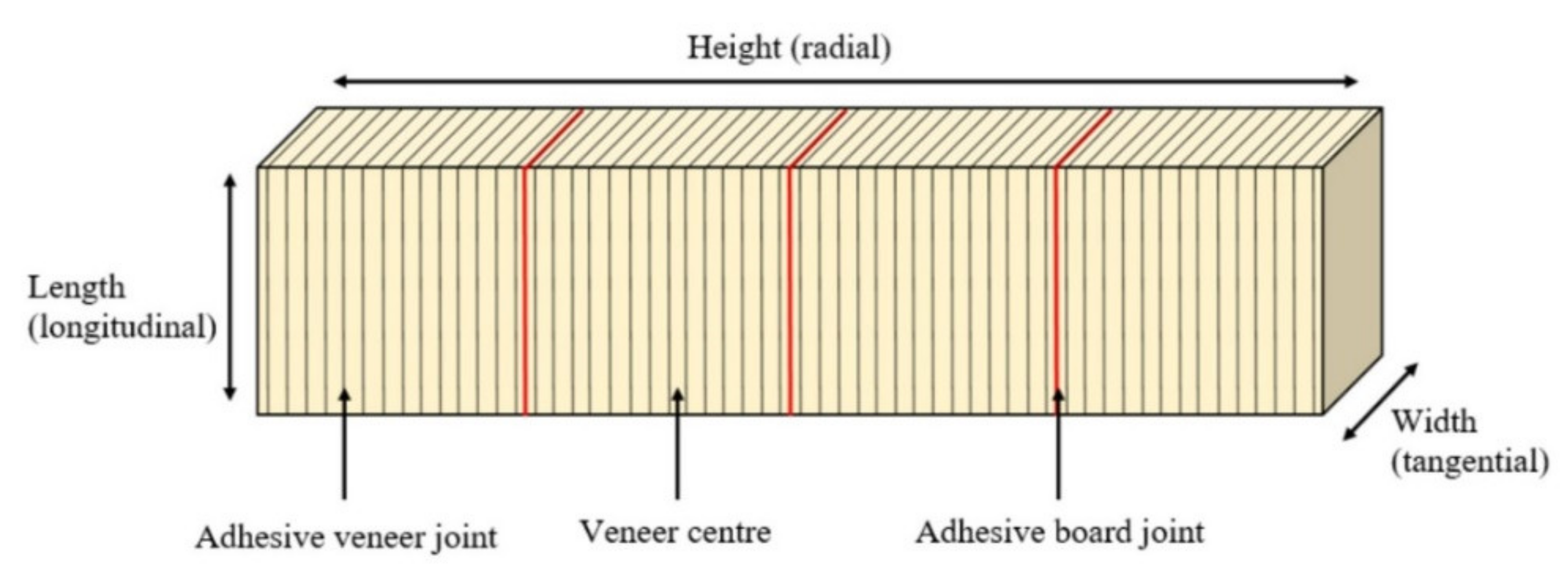Density Profile Analysis of Laminated Beech Veneer Lumber (BauBuche)
Abstract
:1. Introduction
2. Materials and Methods
3. Results and Discussion
4. Conclusions
Supplementary Materials
Author Contributions
Funding
Institutional Review Board Statement
Informed Consent Statement
Data Availability Statement
Conflicts of Interest
References
- Benthien, J.T.; Riegler, M.; Engehausen, N.; Nopens, M. Specific Dimensional Change Behavior of Laminated Beech Veneer Lumber (BauBuche) in Terms of Moisture Absorption and Desorption. Fibers 2020, 8, 47. [Google Scholar] [CrossRef]
- Pollmeier (Hrsg.) POLLMEIER Broschüre BauBuche, Kapitel 03, Bauphysik [BauBuche brochure, Chapter 3, Structural Physics]. 2019. Available online: https://www.pollmeier.com/de/downloads-im-ueberblick (accessed on 19 March 2021).
- Kollmann, F. Technologie des Holzes und der Holzwerkstoffe. In Technology of Wood and Wood-Based Materials; Erster Band; Springer: Berlin, Germany, 1951. [Google Scholar]
- Daoui, A.; Descamps, C.; Marchal, R.; Zerizer, A. Influence of veneer quality on beech LVL mechanical properties. Maderas. Ciencia Tecnología 2011, 13, 69–83. [Google Scholar] [CrossRef] [Green Version]
- Aydın, İ.; Çolak, S.; Çolakoğlu, G.; Salih, E. A comparative study on some physical and mechanical properties of laminated veneer lumber (LVL) produced from Beech (Fagus orientalis Lipsky) and Eucalyptus (Eucalyptus camaldulensis Dehn.) veneers. Holz Roh Werkst. 2004, 62, 218–220. [Google Scholar] [CrossRef]
- Kılıç, M. Some important physical properties of laminated veneer lumber (LVL) made from oriental beech and Lombardy poplar. In AIP Conference Proceedings; No. 1; American Institute of Physics: College Park, ML, USA, 2012; Volume 1479, pp. 397–401. [Google Scholar]
- Knorz, M.; Van de Kuilen, J.W.G. Development of a high-capacity engineered wood product-LVL made of European Beech (Fagus sylvatica L.). In Proceedings of the WCTE 2012: World Conference on Timber Engineering, Auckland, New Zealand, 15–19 July 2012. [Google Scholar]
- Purba, C.Y.C.; Pot, G.; Viguier, J.; Ruelle, J.; Denaud, L. The influence of veneer thickness and knot proportion on the mechanical properties of laminated veneer lumber (LVL) made from secondary quality hardwood. Eur. J. Wood Wood Prod. 2019, 77, 393–404. [Google Scholar] [CrossRef] [Green Version]
- Shukla, S.R.; Kamdem, D.P. Properties of laminated veneer lumber (LVL) made with low density hardwood species: Effect of the pressure duration. Holz Roh Werkst. 2008, 66, 119–127. [Google Scholar] [CrossRef]
- Wei, Y.; Rao, F.; Yu, Y.; Huang, Y.; Yu, W. Fabrication and performance evaluation of a novel laminated veneer lumber (LVL) made from hybrid poplar. Eur. J. Wood Wood Prod. 2019, 77, 381–391. [Google Scholar] [CrossRef]
- Zhang, H.J.; Chui, Y.H.; Schneider, M.H. Compression control and its significance in the manufacture and effects on properties of poplar LVL. Wood Sci. Technol. 1994, 28, 285–290. [Google Scholar] [CrossRef]
- DIN EN 13183-1:2002-07, Feuchtegehalt eines Stückes Schnittholzes—Teil 1 Bestimmung durch Darrverfahren; Deutsche Fassung EN 13183-1:2002. [Moisture content of a piece of sawn timber—Part 1: Determination by oven dry method; German version EN 13183-1:2002].
- Hellerich, W.; Harsch, G.; Haenle, S. Werkstoff-Führer Kunststoffe. In Material Guide Plastics; Carl Hanser, Verlag: München, Germany, 1975. [Google Scholar]
- Mai, C. Personal Communication (Email) on so far Unpublished Research Results; 14:17 CET; Georg-August-Universität Göttingen, Department of Wood Biology and Wood Products: Göttingen, Germany, 2020. [Google Scholar]
- Gavrilović-Grmuša, I.; Dunky, M.; Miljković, J.; Djiporović-Momčilović, M. Radial penetration of urea-formaldehyde adhesive resins into beech (Fagus Moesiaca). J. Adhes. Sci. Technol. 2010, 24, 1753–1768. [Google Scholar] [CrossRef]


| Density (kg m−3) | ||
|---|---|---|
| Specimen | Adhesive Joint Area | Veneer Centre Area |
| 1 | 1192 ± 90 | 726 ± 67 |
| 2 | 1089 ± 105 | 737 ± 69 |
| 3 | 1092 ± 102 | 739 ± 71 |
| 4 | 1118 ± 93 | 740 ± 61 |
Publisher’s Note: MDPI stays neutral with regard to jurisdictional claims in published maps and institutional affiliations. |
© 2021 by the authors. Licensee MDPI, Basel, Switzerland. This article is an open access article distributed under the terms and conditions of the Creative Commons Attribution (CC BY) license (https://creativecommons.org/licenses/by/4.0/).
Share and Cite
Engehausen, N.; Benthien, J.T.; Nopens, M.; Ressel, J.B. Density Profile Analysis of Laminated Beech Veneer Lumber (BauBuche). Fibers 2021, 9, 31. https://0-doi-org.brum.beds.ac.uk/10.3390/fib9050031
Engehausen N, Benthien JT, Nopens M, Ressel JB. Density Profile Analysis of Laminated Beech Veneer Lumber (BauBuche). Fibers. 2021; 9(5):31. https://0-doi-org.brum.beds.ac.uk/10.3390/fib9050031
Chicago/Turabian StyleEngehausen, Nick, Jan T. Benthien, Martin Nopens, and Jörg B. Ressel. 2021. "Density Profile Analysis of Laminated Beech Veneer Lumber (BauBuche)" Fibers 9, no. 5: 31. https://0-doi-org.brum.beds.ac.uk/10.3390/fib9050031





